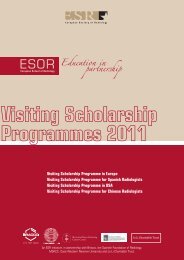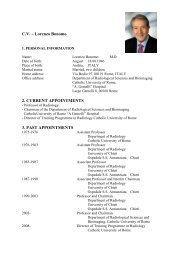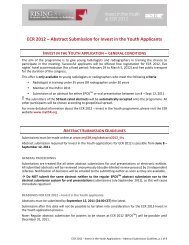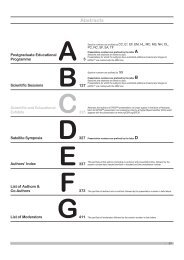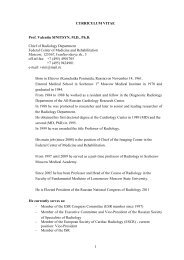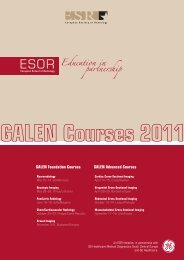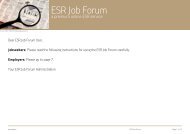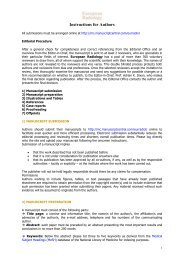Postgraduate Educational Programme - myESR.org
Postgraduate Educational Programme - myESR.org
Postgraduate Educational Programme - myESR.org
- No tags were found...
Create successful ePaper yourself
Turn your PDF publications into a flip-book with our unique Google optimized e-Paper software.
<strong>Postgraduate</strong> <strong>Educational</strong> <strong>Programme</strong>A-151 16:21dGEMRIC (delayed gadolinium-enhanced MR imaging of cartilage)G. Welsch 1 , S. Trattnig 2 ; 1 Erlangen/DE, 2 Vienna/AT (welsch@bwh.harvard.edu)Acute and chronic articular cartilage lesions are a common pathology and manypatients could benefit from cartilage treatment which needs high sophisticatedfollow‐up. Whereas standard morphological approaches can demonstrate theconstitution of cartilage, quantitative/biochemical MR approaches are able toprovide a specific measure of the composition of cartilage. One of the biochemicalMRI techniques most often reported to visualise cartilage ultra-structure is delayedGadolinium-Enhanced MRI of Cartilage (dGEMRIC). Using dGEMRIC, biochemicalMRI has the ability to quantify functionally relevant macromolecules within articularcartilage such as glycosamnioglycans (GAG). GAG are the main source of fixedcharge density in cartilage, which are often decreased in the early stages of cartilagedegeneration and are considered as a key factor in the progression of cartilagedamage. The role of GAG is comparably important in the follow‐up after cartilagerepair procedures where hyaline-like repair tissue with a normal or nearly normalamount of proteoglycans has been described to have a positive predictive value.The technical requirements and possible applications of dGEMRIC are presentedin this „New Horizon session (NH 7) Cartilage imaging“.Learning Objectives:1. To learn the basic principles of dGEMRIC and the current used techniques forclinical imaging.2. To learn about the current clinical applications of dGEMRIC.3. To get an overview of future uses of dGEMRIC in therapeutic studies.A-152 16:39Diffusion tensor imagingC. Glaser; Munich/DE (glaser@rzm.de)DTI aims to monitor water proton diffusion as modified by a tissue’s macromolecularstructure. This implies to apply (and register) at least 6 diffusion sensitizing gradientdirections in order to obtain an adequate diffusion tensor data matrix. Fromthe data metrics, commonly the apparent diffusion coefficient (ADC), fractionalanisotropy (FA) and the principal eigenvector (EV1), are derived to characterisearchitectural tissue properties. This approach has been demonstrated to be feasibleand applicable to articular cartilage in an experimental setting, and promising firstin vivo data of human cartilage have been published. ADC appears to correlateto proteoglycan (PG) and water content and an increase of ADC (both bulk anddepth dependent) has been shown to correlate to (local / bulk) PG depletion. FAreflects depth dependent anisotropy in the collagenous fibre architecture and isindependent of PG content. EV1 has the potential to define cartilage zonal heightbut is the most SNR-demanding parameter of the three. A first in vivo study hasshown very good accuracy for bulk ADC and FA to differentiate healthy volunteersfrom early OA patients and reproducibility data are comparable to dGEMRIC andT2. Most recently, an ex vivo study has obtained an excellent predictive value of DTIfor the diagnosis of early cartilage degeneration and a good ability to grade earlystages of cartilage degeneration - confirming the potential of DTI as a non-invasivenon-CM-dependent biomarker for (early) OA. Current challenges are to implementand standardize robust acquisition protocols for in vivo human and animal imaging.Learning Objectives:1. To discuss basic principles of diffusion imaging in MSK.2. To review technical challenges and current achievements.3. To look into potential future directions.A-153 16:57CEST (chemical exchange saturation transfer)B. Schmitt; Vienna/AT (benjamin.schmitt@meduniwien.ac.at)CEST imaging in principle relies on the chemical exchange of protons bound tosolute molecules and surrounding bulk water molecules. The effect can be usedfor MRI because the magnetization of each solute proton, is also transferred tobulk water, and can thus be visualized via the MR signal. CEST effects can beevaluated for specific molecular groups due to their characteristic proton resonancefrequencies, which provides the technique with a high intrinsic sensitivity to thesegroups. In healthy cartilage tissue, strong CEST effects from exchangeable protonsof glycosaminoglycan (GAG) molecules can be observed. The magnitude of theseeffects decreases when concentration ratio between bulk water protons and GAGprotons decreases, e.g. in the early stages of osteoarthritis (OA). Initial studieson patients after cartilage repair surgery with GAG-dependent CEST (gagCEST)imaging have demonstrated that it is feasible to visualize GAG loss in vivo at 7.0Tesla. Initial reports also claim that the technique might be transitioned to the clinicalfield strength of 3 T. Although CEST imaging can be performed with standardclinical equipment and protocols can easily be implemented in a routine clinicalworkflow, the signal analysis in gagCEST imaging and the reading of gagCESTimages are technically complex. For example, effects, which alter the T2 relaxationtime of tissue such as high relative water concentration, can affect the magnitudeof gagCEST effects although the absolute concentration of GAG is unchanged.Unless confounding effects are automatically corrected, careful analysis of imagesis necessary for proper interpretation of results.Learning Objectives:1. To understand basic principles of CEST imaging.2. To learn about the current status of gagCEST imaging.3. To become aware of technical pitfalls and future approaches.Author Disclosure:B. Schmitt: Research/Grant Support; Siemens Healthcare.Panel discussion:What are the envisaged future advances in these cartilage imagingtechniques and can we expect to introduce them into clinicalpractice? 17:1516:00 - 17:30 Room D1Controversies in Breast ImagingMC 723Should we add ultrasound to mammographicscreening of dense breasts?Moderator:F.J. Gilbert; Cambridge/UKTeaser:A. Tardivon; Paris/FRA-154 16:00A. We can reduce the interval cancer rateW.A. Berg; Pittsburgh, PA/US (wendieberg@gmail.com)Greater rates of interval cancers (detected clinically in the interval between screenings),and even greater mortality, have been observed in women with dense breasttissue (heterogeneously dense or extremely dense mammographically) comparedto those in women whose breasts are fatty or show minimal scattered fibroglandulardensity. Importantly, breast density itself is a strong risk factor for the developmentof non-hereditary breast cancer, with relative risk from extremely dense breasttissue 4- to 5-fold higher than for women with fatty breast tissue. Ultrasound (US)has been considered for supplemental screening of women with dense breasts.Across 8 single-center studies, and three prospective multicenter trials, encompassingover 64,000 examinations, supplemental cancer detection rate of US hasconsistently been 3 to 4 per 1000. Over 90% of cancers seen only on ultrasoundare invasive, with median size of 10 mm. Over 85% of invasive cancers seen onlyon ultrasound are node negative. Interval cancer rate (ICR) after three years ofprogrammatic screening with mammography plus ultrasound was only 8% afterthree years of screening mammography and ultrasound in the ACRIN 6666 study(which evaluated women with dense breasts and at least one other risk factor).In the Italian multicenter trial, after adding US to mammography in women withdense breasts, the ICR was not different than for women with nondense breasts.US carries a substantial risk of false positives, with from 2 to 7% of women biopsiedbecause of screening US, and only 10% of additional biopsies prompted only byUS showing cancer.Author Disclosure:W. A. Berg: Advisory Board; Philips Healthcare. Consultant; Naviscan, Inc.Equipment Support Recipient; Gamma Medica, Inc. Grant Recipient; Hologic,Inc. Research/Grant Support; Gamma Medica, Inc. Speaker; SuperSonic,Imagine.A-155 16:25B. Do we have enough radiologists to do it? Alternatives toultrasound to reduce interval cancersA. Frigerio; Turin/IT (alfonso.frigerio@gmail.com)Mammography screening (MS), i.e. screening with mammography only, is aneffective and efficient means of significantly reducing breast cancer mortality.However, many European countries fail short of complete population coverage.This is largely due to the costs involved and mainly to a shortage in dedicatedradiologists. Moreover, some countries already started, and others are considering,S40AB C D E F G



